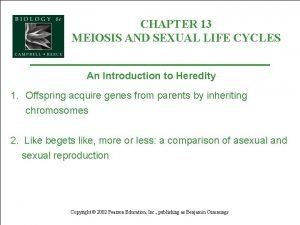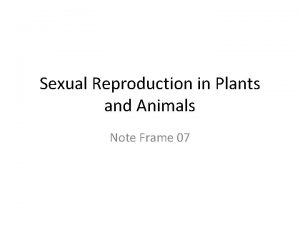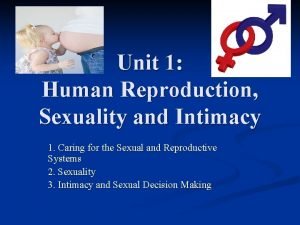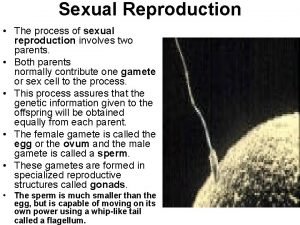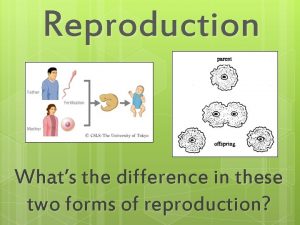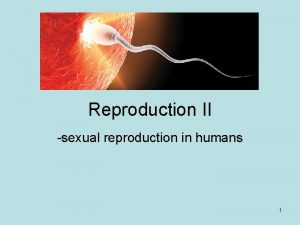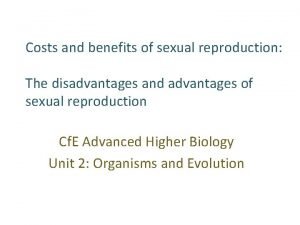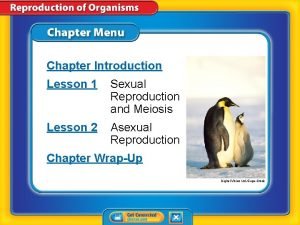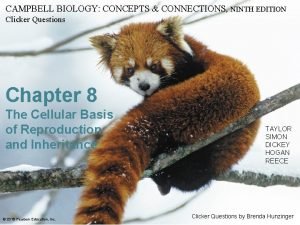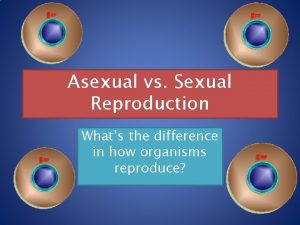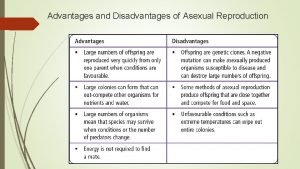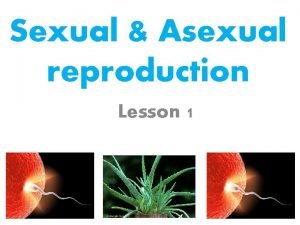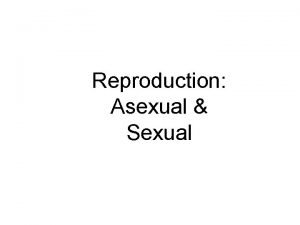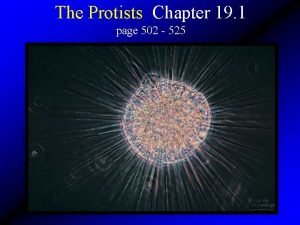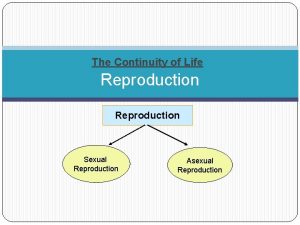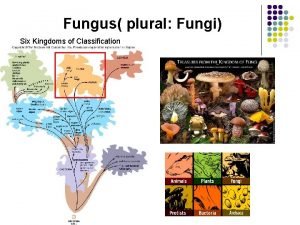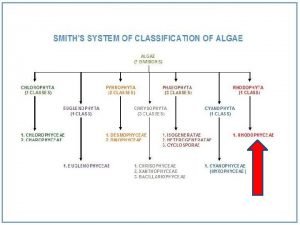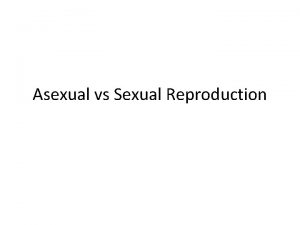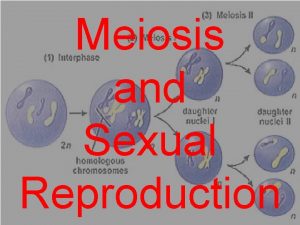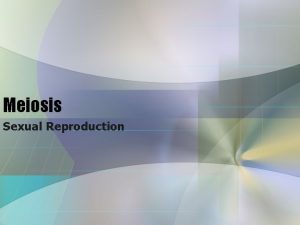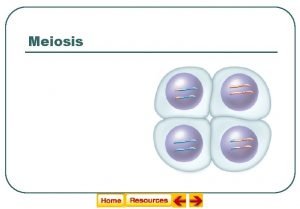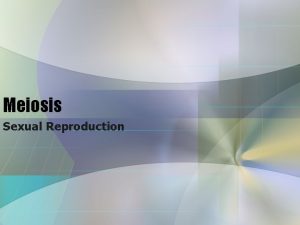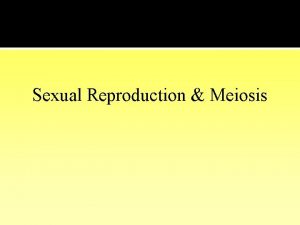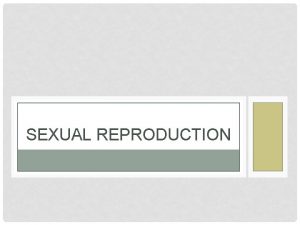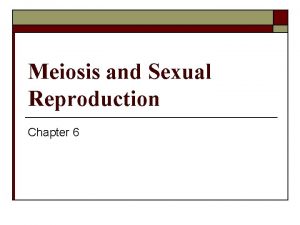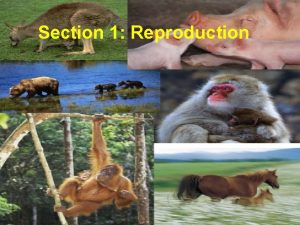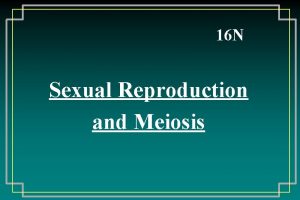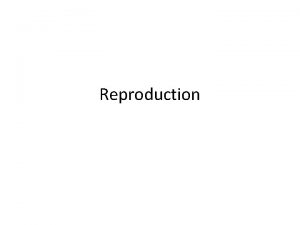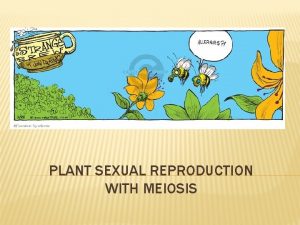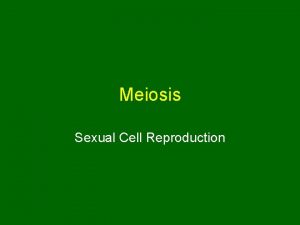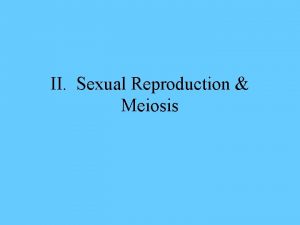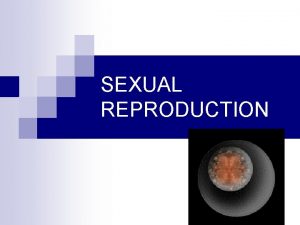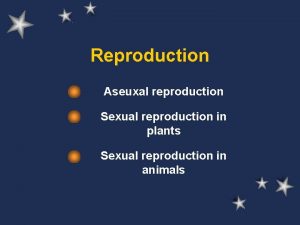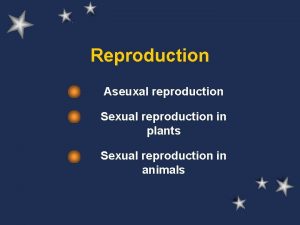Chapter 12 Meiosis and Sexual Reproduction Cengage Learning







































- Slides: 39

Chapter 12 Meiosis and Sexual Reproduction © Cengage Learning 2016

12. 1 Why Sex? • Asexual reproduction produces genetically identical copies of a parent (clones) • In sexual reproduction, offspring arise from two parents and inherit genes from both – An adaptive trait can spread more quickly through a sexually reproducing population than through an asexually reproducing one – Collectively, offspring of sexual reproducers have a better chance of surviving the effects of a harmful mutation that arises in the population © Cengage Learning 2016

Sexual Reproduction in Animals and Plants © Cengage Learning 2016

12. 2 Meiosis in Sexual Reproduction • Sexual reproduction generates new combinations of traits in fewer generations than does asexual reproduction • The process inherent to sexual reproduction that gives rise to this variation is meiosis, a nuclear division mechanism that halves the chromosome number © Cengage Learning 2016

Homologous Chromosomes and Gene Pairs • Somatic (body) cells of humans and other sexually reproducing organisms are diploid • One chromosome of each pair is maternal, and the other is paternal • Except for a pairing of nonidentical sex chromosomes, homologous chromosomes carry the same set of genes © Cengage Learning 2016

Genes and Alleles • Over time, unique mutations accumulate in separate lines of descent – Some of these mutations occur in genes • Alleles are different forms of the same gene – These differences influence the specific traits shared by a species • Offspring of sexual reproducers inherit new combinations of alleles, the basis of traits © Cengage Learning 2016

Genes on Chromosomes Genes occur in pairs on homologous chromosomes. A Corresponding colored patches in this fluorescence micrograph indicate corresponding DNA sequences in a homologous chro- mosome pair. These chromosomes carry the same set of genes. The members of each pair of genes may be identical, or they may differ slightly, as alleles. (Color variations represent sequence differences. ) B Homologous chromosomes carry the same series of genes, but the DNA sequence of any one of those genes might differ just a bit from that of its partner on the homologous chromosome. © Cengage Learning 2016

Gametes and Germ Cells • Sexual reproduction involves the fusion of reproductive cells (gametes) from two parents • In plants and animals, gametes form inside special reproductive structures or organs • Division of immature reproductive cells (germ cells) gives rise to gametes © Cengage Learning 2016

Animal Reproductive Organs testis ovary A Reproductive organs of humans. Meiosis in germ cells inside testes and ovaries produces gametes (sperm and eggs). © Cengage Learning 2016

Plant Reproductive Organs anther B Reproductive organs of a flowering plant. Meiosis produces haploid germ cells inside anthers and ovaries. These cells divide by mitosis to give rise to gametes (sperm and eggs). ovary © Cengage Learning 2016

Meiosis Halves the Chromosome Number • Meiosis in animal germ cells gives rise to eggs (female gametes) or sperm (male gametes) • Gametes have a single set of chromosomes, so they are haploid (n) – Their chromosome number is half of the diploid (2 n) number – Meiosis of a human germ cell (2 n) produces gametes with 23 chromosomes: one of each pair (n) © Cengage Learning 2016

Stages of Meiosis Interphase DNA replication © Cengage Learning 2016 Meiosis II prophase II metaphase II anaphase II telophase II

Two Divisions in Meiosis • Meiosis partitions the chromosomes of one diploid nucleus (2 n) into four haploid (n) nuclei • In meiosis I, each duplicated homologous chromosome is separated from its partner • In meiosis II, sister chromatids are separated © Cengage Learning 2016

How Meiosis Halves the Chromosome Number 1 Chromosomes are duplicated before meiosis begins. During meiosis I, each chromosome in the nucleus pairs with its homologous partner. The nucleus contains two of each chromosome, so it is diploid (2 n). 2 Homologous partners separate and are packaged into two new nuclei. Each new nucleus contains one of each chromosome, so it is haploid (n). The chromosomes are still duplicated. 3 Sister chromatids separate in meiosis II and are packaged into four new nuclei. Each new nucleus contains one of each chromosome, so it is haploid (n). The chromosomes are now unduplicated. © Cengage Learning 2016

Fertilization Restores Chromosome Number • The diploid chromosome number is restored at fertilization • Two haploid gametes (one egg and one sperm) fuse to form a zygote, the first cell of a new individual • Without meiosis before fertilization, the chromosome number would double each generation – Meiosis maintains chromosome number and organism health © Cengage Learning 2016

12. 3 Visual Tour of Meiosis • Meiosis halves the chromosome number • During meiosis, chromosomes of a diploid nucleus become distributed into four haploid nuclei • Meiosis is divided into two stages – Meiosis II © Cengage Learning 2016

Meiosis I – Prophase and Metaphase • Prophase I – Homologous chromosomes condense, pair, and swap segments – Spindle microtubules attach to condensed chromosomes as the nuclear envelope breaks up • Metaphase I – Homologous chromosome pairs align between spindle poles – Spindle microtubules attached to each pair © Cengage Learning 2016

Prophase I and Metaphase I – Illustrated Prophase I Metaphase I Homologous chromosomes condense, pair up, and swap segments. Spindle microtubules attach to them as the nuclear envelope breaks up. Homologous chromosome pairs are aligned between spindle poles. Spindle microtubules attach the two chromosomes of each pair to opposite spindle poles. plasma membran spindle nuclear envelope breaking up © Cengage Learning 2016 pair of homologous chromosomes With thanks to the John Innes Foundation Trustees, computer enhanced by Gary Head

Meiosis I – Anaphase and Telophase • Anaphase I – Homologous chromosomes separate and begin heading toward spindle poles • Telophase I – A complete set of chromosomes clusters are at both ends of the cells – A nuclear envelope forms around each set, forming two haploid (n) nuclei © Cengage Learning 2016

Anaphase I and Telophase I – Illustrated Anaphase I All of the homologous chromosomes separate and begin heading toward the spindle poles. © Cengage Learning 2016 Telophase I A complete set of chromosomes clusters at both ends of the cell. A nuclear envelope forms around each set, so two haploid (n) nuclei form. With thanks to the John Innes Foundation Trustees, computer enhanced by Gary Head

Meiosis II – Prophase and Metaphase • Prophase II – Chromosomes condense – Spindle microtubules attach to each sister chromatid as the nuclear envelope breaks up • Metaphase II – Chromosome align between spindle poles © Cengage Learning 2016

Prophase II and Metaphase II – Illustrated Prophase II Metaphase II The chromosomes condense. Spindle microtubules attach to each sister chromatid as the nuclear envelope breaks up. No DNA replication © Cengage Learning 2016 With thanks to the John Innes Foundation Trustees, computer enhanced by Gary Head

Meiosis II – Anaphase and Telophase • Anaphase II – Sister chromatids separate and begin heading toward spindle poles • Telophase II – A complete set of chromosomes clusters are both ends of the cells – A nuclear envelope forms around each set, so four haploid (n) nuclei form © Cengage Learning 2016

Anaphase II and Telophase II – Illustrated Anaphase II Telotphase II Sister chromatids separate. The now unduplicated chromosomes head to the spindle poles. © Cengage Learning 2016 With thanks to the John Innes Foundation Trustees, computer enhanced by Gary Head

12. 4 How Meiosis Introduces Variation in Traits • Crossovers and the random sorting of chromosomes into gametes result in new combinations of traits among offspring • Along with fertilization, these events contribute to the variation among the offspring of sexually reproducing species © Cengage Learning 2016

Crossing Over in Prophase I • Crossing over is the process by which a chromosome and its homologous partner exchange heritable information in corresponding segments • Crossing over occurs during condensation in prophase I © Cengage Learning 2016

A Here, we focus on only two of the many genes on a chromosome. In this example, one gene has alleles A A and a; the other has alleles B and b. B Close contact between homologous chromosomes promotes crossing over between nonsister chromatids. Paternal and maternal chromatids exchange corresponding pieces. C Crossing over mixes up paternal and maternal alleles on homologous chromosomes. Stepped Art © Cengage Learning 2016

Crossing Over – Illustrated A A a a B B b b A Here, we focus on only two of the many genes on a chromosome. In this example, one gene has alleles A and a; the other has alleles B and b. B Close contact between homologous chromosomes promotes crossing over between nonsister chromatids. Paternal and maternal chromatids exchange corresponding pieces. A A a a B b b B centromere crossover C Crossing over mixes up paternal and maternal alleles on homologous chromosomes. D Each pair of homolo- gous chromosomes can cross over multiple times. This is a normal and com- mon process of meiosis. crossover (A, B, C) © 2016 Cengage Learning; (D), © James Kezer, Courtesy of Dr. Sessions. © Cengage Learning 2016

Chromosome Segregation • Homologous chromosomes can be attached to either spindle pole in prophase I, so each homologue can be packaged into either one of the two new nuclei • Random assortment produces 1023 (8, 388, 608) possible combinations of homologous chromosomes © Cengage Learning 2016

1 The four possible alignments of three pairs of chromosomes in a nucleus at metaphase I. 2 Resulting combinations of maternal and paternal chromosomes in the two nuclei that form at telophase I. 3 Resulting combinations of maternal and paternal chromosomes in the four nuclei that form at telophase II. Eight different combinations are possible. Stepped Art © Cengage Learning 2016

Hypothetical Segregation of Three Pairs of Chromosomes in Meiosis I The four possible alignments of three pairs of chromosomes in a nucleus at metaphase I. Resulting combinations of maternal and paternal chromosomes in the two nuclei that form at telophase I. Resulting combinations of maternal and paternal chromosomes in the four nuclei that form at telophase II. Eight different combinations are possible. © Cengage Learning 2016

12. 5 Mitosis and Meiosis—An Ancestral Connection? • Though they have different results, mitosis and meiosis are fundamentally similar processes • Meiosis may have evolved by the remodeling of existing mechanisms of mitosis © Cengage Learning 2016

Comparing Mitosis and Meiosis • Mitotic (asexual) reproduction produces clones of the parent • Meiotic (sexual) reproduction usually produces offspring that different genetically from the parent and from one another • Despite these different end results, the stages of mitosis and meiosis II are striking parallel © Cengage Learning 2016

Comparing Mitosis and Meiosis – Mitosis MITOSIS One diploid nucleus to two diploid nuclei Prophase • Chromosomes condense. • Spindle forms and attaches chromosomes to spindle poles. • Nuclear envelope breaks up. © Cengage Learning 2016 Metaphase • Chromosomes align midway between spindle poles. Anaphase • Sister chromatids separate and move toward opposite spindle poles. Telophase • Chromosome clusters arrive at spindle poles. • New nuclear envelopes form. • Chromosomes loosen up.

Comparing Mitosis and Meiosis – Meiosis MEIOSIS II Two haploid nuclei to four haploid nuclei Prophase II • Chromosomes condense. • Spindle forms and attaches chromosomes to spindle poles. • Nuclear envelope breaks up. © Cengage Learning 2016 Metaphase II • Chromosomes align midway between spindle poles. Anaphase II • Sister chromatids separate and move toward opposite spindle poles. Telophase II • Chromosome clusters arrive at spindle poles. • New nuclear envelopes form. • Chromosomes loosen up.

Evidence in BRCA Genes • Molecular products of BRCA genes monitor and repair breaks in DNA – For example, during DNA replication prior to mitosis • These same molecules monitor and fix breaks in homologous chromosomes during crossing over in prophase I of meiosis © Cengage Learning 2016

Mutation in BRCA Genes • Mutations that affect these molecules can affect the outcomes of both mitosis and meiosis • Sexual reproduction probably originated by mutations that affected mitosis – Remodeling of existing processes into new ones is a common evolutionary theme © Cengage Learning 2016

MLH 1 © Cengage Learning 2016

Points to Ponder • Why do cells undergoing mitosis require one set of divisions, but cells undergoing meiosis need two sets of divisions? • Why does crossing over occur in prophase of meiosis and not in mitosis? • Why is sexual reproduction considered a hallmark of evolutionary advancement? © Cengage Learning 2016
 Asexualk
Asexualk Sexual reproduction and genetics section 1 meiosis
Sexual reproduction and genetics section 1 meiosis Sexual reproduction and genetics section 1 meiosis
Sexual reproduction and genetics section 1 meiosis The disadvantages of sexual reproduction
The disadvantages of sexual reproduction Venn diagram of sexual and asexual reproduction in animals
Venn diagram of sexual and asexual reproduction in animals Chapter 10 sexual reproduction and genetics
Chapter 10 sexual reproduction and genetics Chapter 10 sexual reproduction and genetics
Chapter 10 sexual reproduction and genetics Metaphase ii
Metaphase ii Chapter 13 meiosis and sexual life cycles
Chapter 13 meiosis and sexual life cycles Sexual reproduction
Sexual reproduction Crossing over occurs during
Crossing over occurs during Chapter 10 section 1 meiosis answer key
Chapter 10 section 1 meiosis answer key Chapter 10 section 1 meiosis
Chapter 10 section 1 meiosis Difference of sexual and asexual reproduction
Difference of sexual and asexual reproduction Chromosomes in organisms
Chromosomes in organisms Asexual vs sexual reproduction venn diagram
Asexual vs sexual reproduction venn diagram Is mitosis asexual
Is mitosis asexual Example of budding asexual reproduction
Example of budding asexual reproduction Asexual and sexual reproduction difference
Asexual and sexual reproduction difference Budding asexual reproduction
Budding asexual reproduction Example of budding
Example of budding 2009 delmar cengage learning
2009 delmar cengage learning Cengage learning chapter 7 answers
Cengage learning chapter 7 answers Sexual reproduction in human
Sexual reproduction in human Sexual reproduction stages
Sexual reproduction stages Define sexual reproduction
Define sexual reproduction What is reproduction
What is reproduction Sexual reproduction in human
Sexual reproduction in human Disadvantage of sexual reproduction
Disadvantage of sexual reproduction Reproduction of organisms
Reproduction of organisms Biology
Biology Whats asexual reproduction
Whats asexual reproduction Disadvantages of sexual reproduction
Disadvantages of sexual reproduction Significance of sexual reproduction
Significance of sexual reproduction Advantages of genetic diversity
Advantages of genetic diversity Chapter 19 protists study guide answers
Chapter 19 protists study guide answers Sexual or asexual reproduction
Sexual or asexual reproduction Conjugated fungi
Conjugated fungi Red algae classification
Red algae classification Sexual or asexual reproduction
Sexual or asexual reproduction








